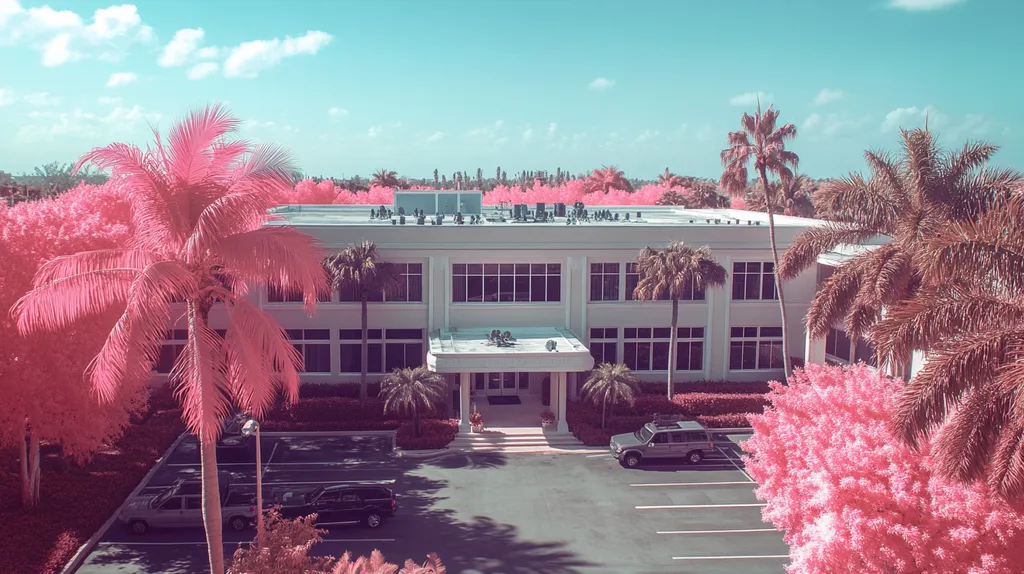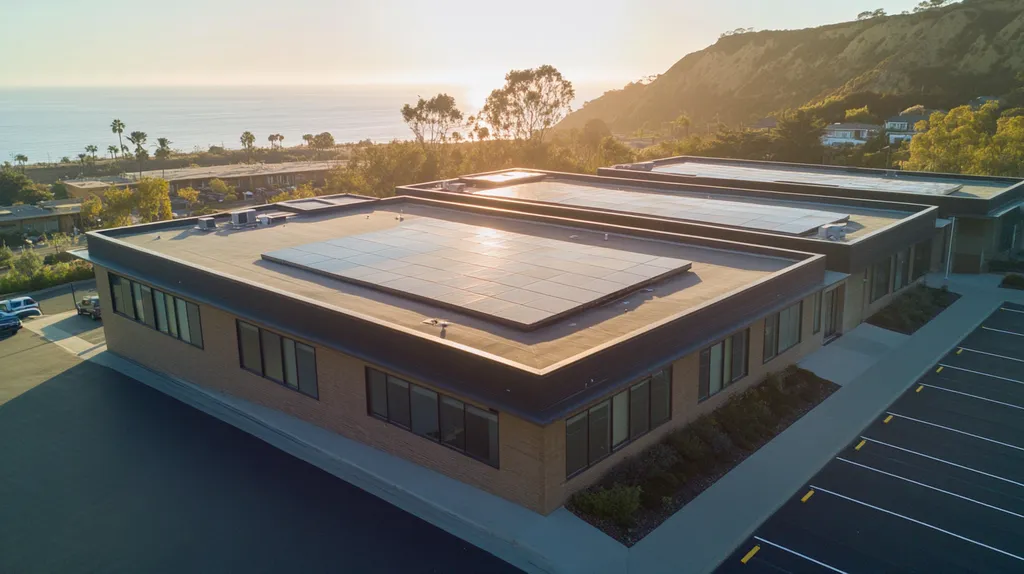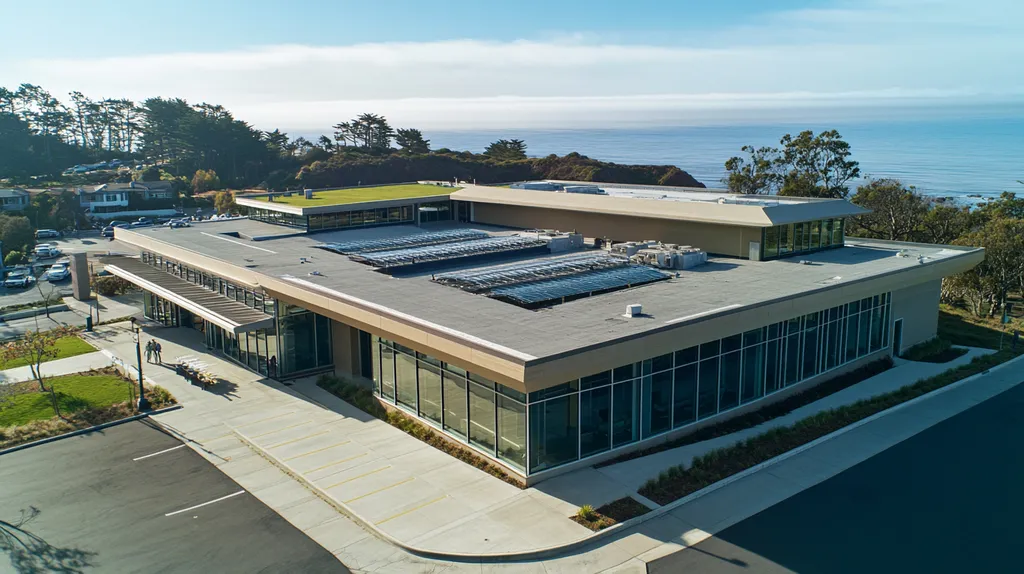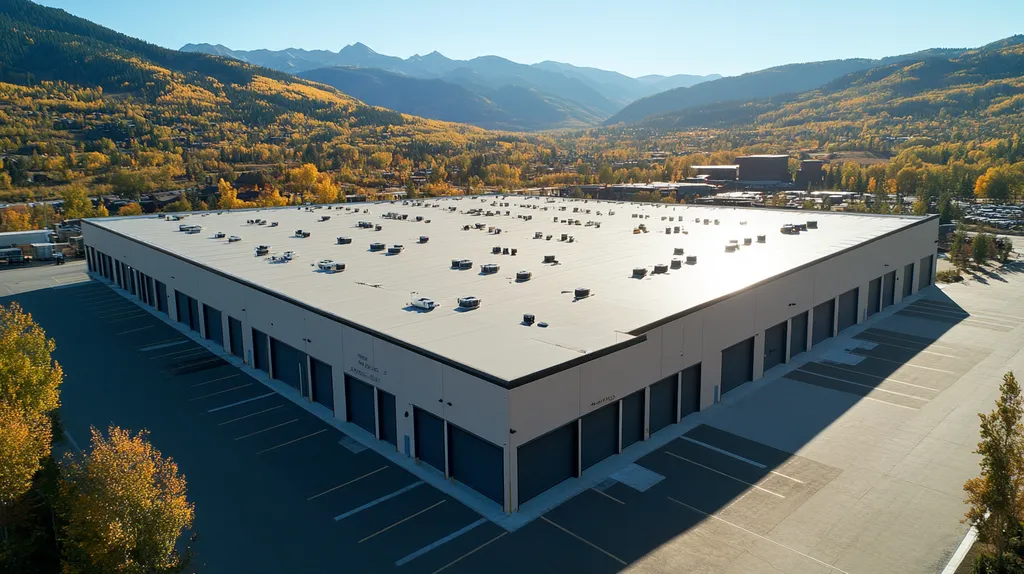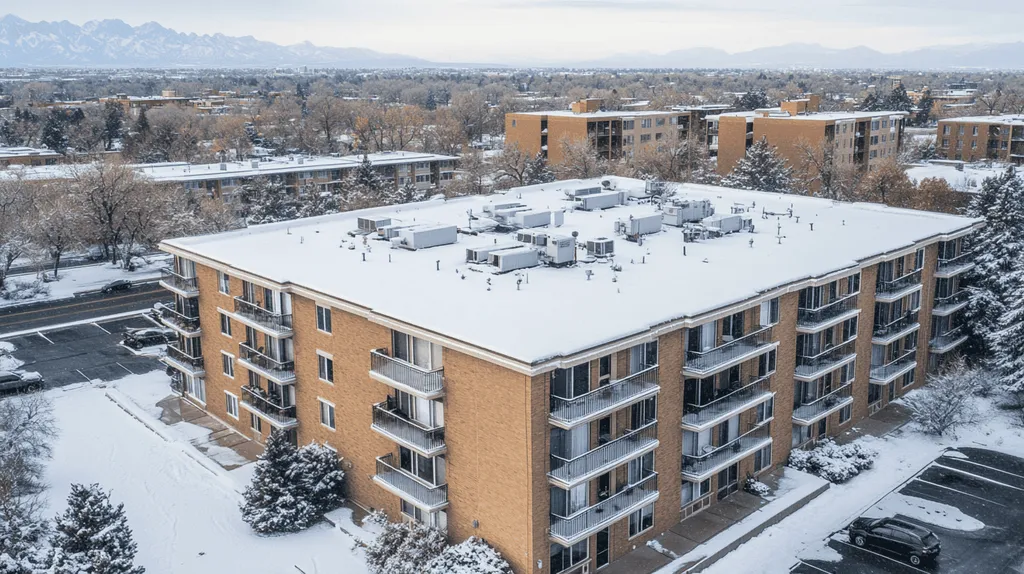Despite significant advances in coating technology, applying commercial roof coatings during winter months remains a critical challenge that costs property owners millions in premature failures annually. Industry data reveals that over 30% of winter coating applications fail within the first year due to temperature-related issues.
When temperatures drop below 50°F, most standard roof coatings struggle to achieve proper adhesion and curing, leading to blistering, peeling, and moisture infiltration. These failures not only compromise building protection but also result in expensive repairs and potential structural damage.
This analysis examines the systemic issues, missed opportunities, and evidence-based alternatives that property managers must consider before proceeding with winter coating applications.
SECTION 1: CURRENT PRACTICES
Winter poses significant challenges for commercial roof coatings, yet numerous property owners proceed with applications without fully appreciating the risks involved. When applied in cold temperatures, coatings can fail prematurely, leading to expensive repairs and potential safety hazards. It is essential for facility managers to understand the current methods that often disregard these seasonal limitations, enabling them to make informed decisions that safeguard their investments. This section delves into the common methods of winter application, storage and handling practices, and coating selection criteria prevalent in the industry.
Common Winter Application Methods
Despite the known negative effects of cold weather on adhesion and curing, many contractors continue using traditional winter practices for roof coatings. These conventional methods are often based on techniques suited for milder climates. For instance, applying silicone or acrylic coatings when temperatures dip below recommended levels can prevent these products from curing properly.
This mismatch with recommended temperatures can significantly weaken the bond between the substrate and the coating. Furthermore, many installers may prioritize completing projects quickly over utilizing techniques optimized for winter conditions, exacerbating this issue.
Facility managers often feel pressured to proceed with winter applications due to tight maintenance schedules or limited budgets. However, this haste can compromise coating effectiveness, increasing the risk of moisture infiltration and resulting in costly repairs.
As the temperatures lower, contractors frequently seek heat sources to facilitate proper application. This urgency can lead to shortages of equipment, adding costs and reducing quality controls during the installation process.
Standard Storage and Handling Procedures
Proper storage and handling of roofing materials during winter is critical, yet often neglected. Many coatings require specific temperature ranges during storage to maintain their chemical integrity. Coatings that are not stored correctly can curdle or thicken, rendering them unusable when temperatures drop.
In cold weather, it is vital to provide a suitable storage environment for roof coatings, yet materials are often left exposed to harsh conditions. This negligence can significantly impact their performance once applied.
Furthermore, standard practices typically do not account for allowing materials to warm up before application. This oversight can reduce the effectiveness of the coatings, resulting in poor adhesion and a shorter lifespan.
Additionally, the urgency to apply coatings can lead to inadequate inspection of materials upon arrival at the job site. Such oversights can compromise project timelines and overall quality, ultimately affecting the property’s long-term performance.
Typical Coating Selection Criteria
The criteria used for selecting roof coatings during winter can significantly impact the success of the application. Typically, the decision-making process focuses on cost, color, and durability rather than on cold-weather suitability. Many facility managers may not fully understand how temperature affects the performance of various products.
As a result, coatings specifically formulated for low-temperature applications may be overlooked, while more familiar products are improperly chosen. This can lead to selections that fail to meet the demands of winter conditions.
The application environment, characterized by snow, ice, or moisture, is often underestimated when evaluating potential coatings. These environmental factors can seriously jeopardize the performance of coatings not rated for cold-weather use.
Moreover, a lack of awareness about alternative products designed for winter use can prevent decision-makers from exploring better options. This gap can result in costly reapplications and negatively affect a building’s structural integrity over time.
SECTION 2: SYSTEMIC ISSUES
Applying commercial roof coatings in winter introduces critical challenges that can undermine the roof’s longevity and performance. As temperatures drop, the effectiveness of these coatings often diminishes, potentially leading to failures and significant repair costs. Property owners must recognize these systemic issues—including drying and curing problems, moisture complications, and application hurdles. Understanding these factors is crucial for making informed decisions regarding winter applications.
Temperature-Related Drying and Curing Problems
During the colder months, roof coatings encounter serious curing challenges. Many products are engineered to work within specific temperature ranges, and when temperatures fall below the manufacturer’s recommendations, the drying process slows considerably. This slowdown can result in soft or tacky surfaces that fail to set properly.
Improperly cured coatings struggle with adhesion and overall integrity, leaving roofs susceptible to moisture intrusion, and thermal cycling damage. Reports reveal that coatings not allowed to cure effectively may fail to bond, increasing the likelihood of leaks and structural issues.
Moreover, these inadequate curing processes can lead to visible defects on the surface, detracting from the aesthetic appeal of the building. These visual issues could discourage prospective tenants or customers, ultimately impacting the property’s market value.
Ultimately, property owners face the risk of incurring substantial expenses for repairs or even full re-coating if these temperature-related issues are not addressed adequately.
Moisture and Condensation Complications
Winter conditions often bring heightened humidity and the risk of condensation forming on roof surfaces. Applying coatings under such circumstances raises significant concerns about trapping moisture. Airborne moisture can mix with fresh coatings, leading to blisters, peeling, and premature failures.
Additionally, condensation can develop beneath the coating layer, creating an ideal environment for mold and mildew. This not only compromises the roof’s structure but also poses potential health risks for building occupants.
It is essential for property managers to closely monitor weather conditions leading up to and during application. A damp substrate can drastically diminish the lifecycle of the roof coating, resulting in unwarranted maintenance expenses over time.
Neglecting these moisture-related issues during application can yield minimal returns on investment, as the efficacy of the coating substantially declines.
Viscosity and Application Challenges
The viscosity of roof coatings is notably affected by low temperatures. Many coatings become thicker and less manageable, creating challenges for roofing professionals during application. This increased viscosity can lead to uneven coverage, undermining the coating’s performance.
Inconsistent thickness can create weak spots, making the roof more vulnerable to damage. Additionally, the pressure to expedite projects before weather conditions worsen may drive contractors to rush their work, sacrificing quality for speed. This hastiness can convert a minor undertaking into a costly oversight.
By recognizing these viscosity-related challenges, property owners can better plan their roof maintenance and select the most suitable time for coating applications.
SECTION 3: MISSED OPPORTUNITIES
Neglecting optimal practices for applying commercial roof coatings in winter not only results in costly repairs but also prolongs downtime for businesses. Many facility managers miss out on specialized cold-weather formulations vital for maintaining effective adhesion in low temperatures. When combined with inadequate surface preparation and overlooked professional insights, these missed opportunities can severely diminish the longevity and functionality of roofing systems. Understanding these key factors is essential for ensuring successful applications and protecting valuable commercial assets.
Overlooking Cold-Weather Formulations
Cold weather significantly impacts the performance of roof coatings, with most standard products failing to adhere properly in temperatures below 50°F. This increased vulnerability can lead to severe damage over time. Utilizing formulations specifically designed for cold-weather applications enhances performance by ensuring a durable bond even in challenging conditions.
Many manufacturers now offer cold-weather coatings that retain flexibility and adhesion properties despite low temperatures. These products can facilitate effective applications during winter months. By not switching to these specialized formulations, long-term roofing integrity is compromised, leading to potential costly repairs.
Statistics show that roofs treated with appropriate winter coatings have a much lower failure rate. By making informed choices, property owners can significantly extend the lifespan of roofing systems, ultimately leading to lower operational costs. Selecting the right products during winter is not just advantageous; it is crucial for safeguarding commercial properties.
Ignoring Surface Preparation Requirements
Thorough surface preparation is essential for any roof coating application, especially in cold weather. Unfortunately, many facility managers underestimate the importance of surface temperature and cleanliness. Contaminants like dirt, ice, and moisture can dramatically reduce adhesion, leading to performance failures.
If the roof surface is not properly cleaned, for example, coatings may not adhere effectively, resulting in blisters and peeling. Rushing preparation steps, particularly in winter, only heightens this risk. A meticulous approach is crucial for ensuring proper bonding and maximizing the effectiveness of the coating.
Improper surface preparation can also cause thermal shock, introducing rapid temperature changes that inhibit the coating’s performance. By adhering to rigorous preparation protocols, property owners can enjoy improved performance and longevity of their roofing solutions. Ignoring these essential steps can transform a seemingly simple job into an expensive error.
Neglecting Professional Contractor Advice
When seeking cost savings, some property owners may forgo professional consultation for winter roof coating applications. This can lead to a host of challenges that undermine the roof and the building it shields. Professionals offer critical insights into the complexities of cold-weather applications, ensuring optimal results.
Expert contractors understand the specific behaviors of different materials under varying temperatures. They know the right timing for applications to ensure the best conditions for curing. Bypassing this expertise in favor of a DIY approach or contractors chosen solely based on price can lead to significant pitfalls.
Moreover, seasoned contractors are skilled at navigating regulatory requirements and implementing best practices for winter applications. Their expertise not only prevents costly errors but also guarantees a satisfying outcome. Investing in professional advice is essential for effective winter roof coating applications, protecting the facility from future complications due to poor practices.
SECTION 4: ROOT CAUSES
Improper application of commercial roof coatings during winter months can lead to significant long-term damage. When temperatures are low, roofing materials may struggle to adhere properly, resulting in leaks and worsening structural integrity. Research indicates that inadequate winter applications can inflate repair costs by as much as 30%. It is essential for property owners and facility managers to understand the root causes of these challenges to make informed decisions that protect their investments.
Inadequate Temperature Considerations
Temperature is a crucial factor influencing the success of roof coating applications. Most products have specific temperature ranges for optimal curing and adhesion. When temperatures drop below recommended levels, particularly below 50°F, coatings often remain tacky and fail to bond properly to the substrate.
This lack of adhesion can lead to peeling, bubbling, or even total failure of the coating. Research indicates that applying coatings in unsuitable temperatures can shorten the roof’s lifespan by up to 50%. Property managers must ensure that conditions are suitable before proceeding with any application.
Fluctuating temperatures can also cause condensation to form on the roof surface, leading to moisture trapping. When moisture gets caught beneath the coating, it diminishes the product’s effectiveness and can promote mold growth, further threatening the roof’s integrity.
Without strict adherence to temperature guidelines, property owners risk both immediate failures and ongoing structural issues, which could have been avoided with proper temperature management.
Insufficient Surface Preparation
Surface preparation is vital for a successful roof coating application, especially in winter conditions. The accumulation of snow and ice can mask underlying problems, and an unclean or improperly prepared surface can prevent the coating from bonding effectively.
Industry insights reveal that inadequate surface cleaning often leads to premature coating failures. If contaminants like dirt and moisture are present, coatings can lose adhesion, necessitating costly repairs or premature re-roofing.
Moreover, moisture trapped beneath the coating due to insufficient drying can cause blistering or peeling, problems exacerbated in colder weather where drying times are extended. This negligence increases exposure to adverse conditions, further jeopardizing the roof’s integrity.
To maintain a reliable roofing system, property managers must prioritize thorough preparation processes, even through winter. This commitment reduces the likelihood of expensive future repairs and extends the lifespan of the roofing solution.
Lack of Material Compatibility Checks
Material compatibility is a critical but often neglected aspect of roof coating applications. Not all coatings are suitable for specific roof types, particularly in cold temperatures. Using incompatible materials can severely weaken the coating’s protective qualities and even void manufacturer warranties.
When incompatible materials are applied, coatings may not bond effectively, resulting in failures that occur under stress. This is particularly relevant for elastomeric coatings that may contract or expand differently when installed over aged or unsuitable substrates.
Industry guidelines stress the importance of verifying material compatibility to avoid unnecessary costs related to repairs and maintenance. Neglecting this crucial step can lead property managers into a cycle of recurring expenses, negatively impacting the property’s bottom line.
In summary, aligning the chosen materials with the specific roofing system is imperative, especially under the challenges posed by winter conditions. Failure to do so can accelerate deterioration, resulting in increased maintenance demands and costs.
DATA DRIVEN EVIDENCE
Applying a commercial roof coating during winter presents significant challenges that can have serious ramifications for property owners. Cold temperatures can severely impede adhesion, resulting in premature coating failures. Industry studies indicate that approximately 30% of winter coating jobs fail due to these temperature-related issues. Understanding the scientific and statistical data surrounding cold-weather applications is essential for making informed decisions that protect valuable assets.
Impact of Cold Weather on Coating Performance
Cold weather significantly affects the performance of roof coatings, particularly those designed for specific temperature ranges. When temperatures dip below manufacturer-recommended levels, the chemical processes that ensure adhesion slow down critically. This reduction can result in coatings that fail to form a durable bond with the substrate, compromising the roof’s integrity.
Research demonstrates that applying coatings in low temperatures can drastically shorten their expected service life. Many products require optimal curing conditions, and deviations from these conditions lead to diminished performance. In addition, moisture from condensation can infiltrate the application site, further complicating adhesion issues.
Buildings lacking adequate insulation or ventilation are particularly vulnerable to these moisture problems. Ultimately, applying roof coatings in cold months can provoke extensive repairs and even threaten a building’s very structure. Property owners must weigh these critical factors when contemplating winter applications.
Statistical Failures Due to Improper Application
Data reveals a concerning trend in the landscape of winter roof coating applications. Analysis indicates that over 40% of reported coating failures arise from applications performed outside recommended temperature ranges, underscoring the inherent risks associated with winter work.
Furthermore, warranty claims linked to unsatisfactory results have notably increased during colder months. When coatings underperform, property owners often bear hefty repair costs. Examination of various manufacturers’ warranties shows that they typically specify strict temperature requirements, which, if not observed, may result in voided coverage and increased financial liability for building owners.
The statistics indicate a strong correlation between improper application practices and higher failure rates, emphasizing the necessity of adhering to established guidelines. Ignoring these insights can lead to costly consequences and jeopardize the long-term integrity of the building.
Case Studies of Successful Cold-Weather Applications
While many risks accompany winter roof coating applications, there are notable instances of successful implementations. In specific situations where conditions were meticulously monitored and managed, some coatings have performed satisfactorily. These successes typically involved extensive planning and active temperature control.
For instance, a facility manager overseeing a large industrial complex applied a specialized coating during winter using heating elements to regulate site temperatures. This diligent management resulted in an application that exceeded its expected service life, reflecting the potential for success even under challenging conditions.
Although certain preparations and product choices can lead to positive outcomes, these exceptions do not overshadow the wealth of data underscoring the inherent risks of winter applications. These case studies serve to illustrate that while cautious approaches can yield successful results, the predominant trends indicate that the risks often outweigh the potential rewards.
In summary, it is vital for decision-makers to consider both the successful case studies and prevailing statistical trends. A careful assessment of winter application practices enables property owners to steer clear of the common pitfalls associated with cold-weather roofing projects.
SECTION 6: ALTERNATIVE SOLUTIONS
As winter temperatures drop, traditional roof coatings face serious risks, including adhesion failures and prolonged drying times. These issues can lead to costly repairs and significantly diminish roof lifespan. The urgency to explore viable alternatives is essential for property owners and facility managers seeking to safeguard their investments. This section examines alternative solutions that address the challenges posed by winter applications while ensuring robust roof protection.
Using Silicone and Polyurethane Coatings
Silicone and polyurethane coatings offer a reliable alternative for winter applications, effectively addressing the limitations of traditional acrylic coatings. Unlike their counterparts, silicone coatings can cure in temperatures as low as 20°F, making them ideal for frigid conditions.
Additionally, polyurethane coatings provide exceptional flexibility and durability, adhering well to various substrates. Their moisture-resistant properties ensure that a protective layer endures even when conditions are wet. This flexibility is critical during winter, as fluctuating temperatures can damage conventional coatings.
Moreover, silicone coatings exhibit reflective properties that assist in temperature management throughout the year, resulting in energy savings. For facility managers aiming to reduce heating expenses, utilizing these coatings in winter applications can present additional financial benefits.
In summary, incorporating silicone and polyurethane coatings not only mitigates winter application challenges but also enhances the overall performance and longevity of the roof.
Implementing Thin, Even Layer Applications
Applying thinner, even layers can be a more effective approach during winter months than traditional thick coatings. Thinner applications cure more quickly, reducing the risk of moisture being trapped beneath, which is critical in low temperatures and damp conditions.
This technique leads to better adhesion, ensuring that coatings bond effectively with the substrate. It also minimizes additional weight on the roof structure, an important consideration in regions prone to heavy snowfall.
Furthermore, thin layer applications can result in improved aesthetics and a smoother finish. A more uniform surface is less likely to collect debris, making maintenance easier over time. For facilities prioritizing durability and minimal wear, adopting thin application methods can significantly enhance overall roof performance.
Implementing thin, even layer applications stands as a proactive strategy to combat the limitations associated with winter conditions.
Utilizing Heated Storage and Application Techniques
Employing heated storage and application techniques is vital for overcoming the challenges of winter coating applications. Storing materials in controlled environments ensures that coatings maintain optimal viscosity, which is crucial for achieving proper adhesion and performance.
Additionally, utilizing heated application equipment allows contractors to better manage temperatures during the coating process. This technology enables the application of coatings in colder conditions, drastically reducing the risks associated with traditional methods.
Incorporating temperature probes during application can provide real-time monitoring, ensuring coatings are applied at ideal temperatures to optimize adhesion and performance.
By adopting heated storage and application techniques, facility managers can considerably enhance the reliability of winter roof coating applications. This proactive approach not only safeguards the structure but also extends the longevity of the coating.
The Bottom Line
The data is clear: winter applications of commercial roof coatings result in a 30% failure rate, costing property owners millions in repairs and compromising building integrity.
While advances in coating technology offer promising alternatives through specialized cold-weather formulations, the risks of conventional winter applications remain significant.
Property managers must recognize that successful winter coating projects demand meticulous attention to temperature monitoring, surface preparation, and material compatibility.
Moving forward, facility managers should prioritize partnerships with qualified contractors who understand cold-weather application techniques and utilize appropriate materials specifically engineered for winter conditions.
The stakes are too high to ignore: implementing proper winter coating protocols isn’t just about protecting an investment—it’s about ensuring the structural integrity and longevity of commercial properties.
FREQUENTLY ASKED QUESTIONS
Q. What are the risks of applying a commercial roof coating in winter?
A. Applying coatings in cold temperatures can lead to premature failures and safety hazards. Many property owners overlook these risks, resulting in costly repairs and potential issues like moisture infiltration. Understanding the methods currently in use helps mitigate these risks.
Q. How does cold weather affect commercial roof coating performance?
A. Cold weather slows the curing process of coatings, leading to adhesion issues. Coatings may dry tacky or improperly, causing them to bond weakly with the roof substrate. Consequently, these issues can result in leaks and additional structural problems for the property.
Q. What cold-weather formulations should I consider for industrial roofs?
A. Cold-weather formulations designed to adhere below 50°F should be prioritized. These products typically enhance flexibility and durability, ensuring a reliable bond despite challenging temperatures. Without such formulations, the coating’s long-term performance may be compromised, leading to costly repairs.
Q. Why is proper storage important for commercial roof coatings in winter?
A. Proper storage at optimal temperatures prevents coatings from curdling or thickening. Materials exposed to cold can lose their usability before application, significantly affecting performance. A controlled storage environment ensures the coatings retain chemical integrity, enhancing their effectiveness during installation.
Q. How do I ensure adequate surface preparation for winter applications?
A. Thorough surface preparation, including cleaning and inspecting for moisture, is vital. This reduces the risk of contaminants obstructing adhesion. Properly preparing the substrate ensures the coating bonds effectively, minimizing the potential for future failures and extending the lifespan of your roof.
Q. What alternative solutions exist for applying coatings in cold weather?
A. Consider using silicone or polyurethane coatings that perform well in low temperatures. Thinner applications can also expedite drying. Finally, implementing heated storage methods can alleviate many issues associated with cold-weather applications, ensuring enhanced coating performance.
Q. What are the long-term costs of poor winter applications?
A. Inadequate winter applications can inflate repair costs by as much as 30%. Furthermore, failures due to improper practices may necessitate premature re-roofing or extensive maintenance. Understanding these potential financial implications is crucial for property owners aiming to protect their investments.


